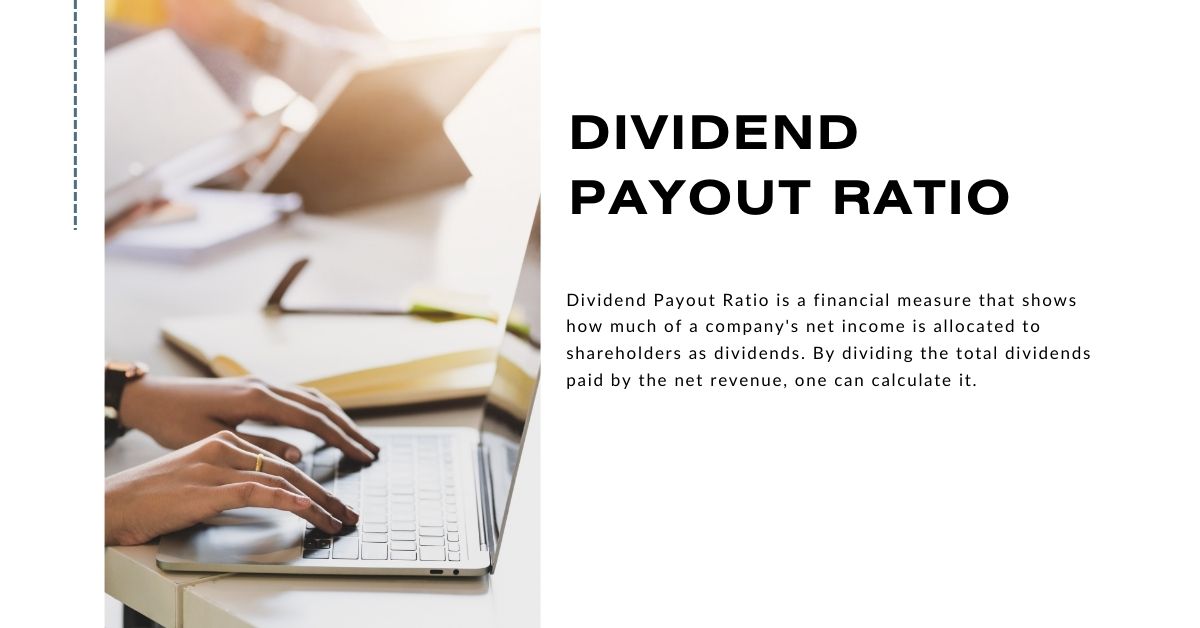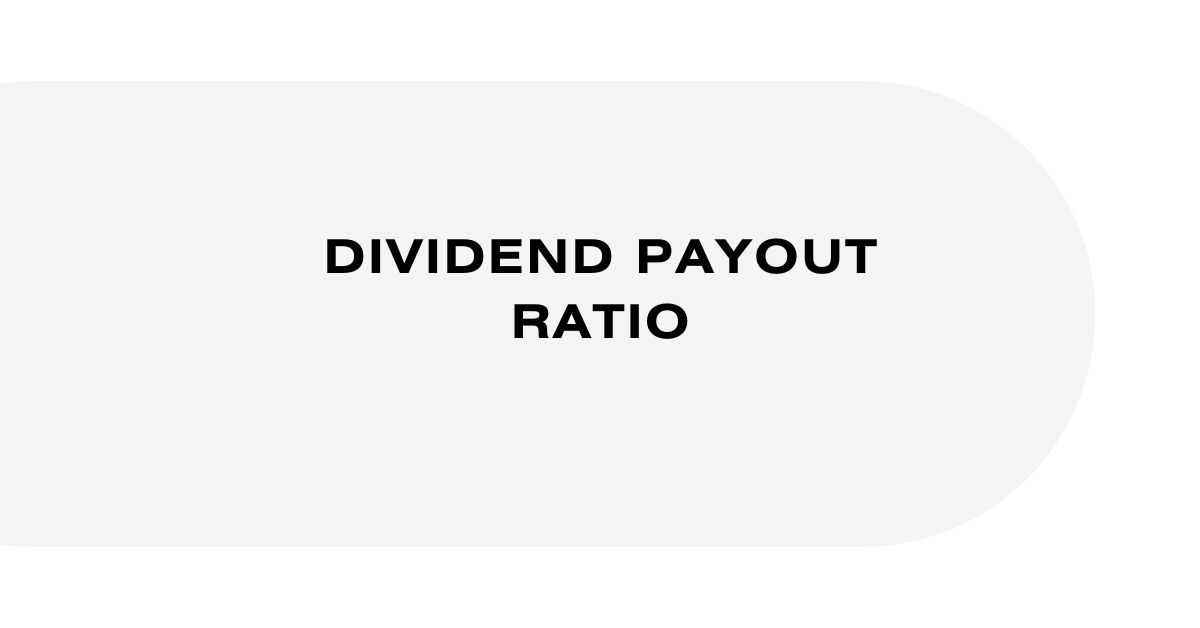Dividends are a common way for companies to share a portion of their earnings with shareholders. The dividend payout ratio informs investors just how much of a company’s income is distributed. While some businesses choose to share a large portion of their profits with investors, others prefer to share less.
This article will explain what the dividend payout ratio is, how it is calculated, and how it may be used to make sound investing decisions.
What is Dividend Payout Ratio?

Dividend Payout Ratio is a financial measure that shows how much of a company’s net income is allocated to shareholders as dividends. By dividing the total dividends paid by the net revenue, one can calculate it.
A high payout ratio indicates that a corporation returns a sizable amount of its earnings to shareholders, whereas a low ratio indicates that the company keeps a bigger portion of its income for reinvestment or other uses. Investors frequently use this ratio to assess a company’s dividend policy and ability to maintain future dividend payments.
Dividend Payout Ratio Formula
The dividend payout ratio is a financial indicator that calculates the percentage of a company’s net income that is paid to shareholders in dividends. By dividing the total dividends paid by the net revenue, one can calculate it. The formula goes as follows:
Dividend Payout Ratio = (Total Dividends Paid)/(Net Income)
This ratio enables investors to understand how a company allocates its profits. A high payout ratio implies that a major amount of the firm’s earnings are returned to shareholders, whereas a low payout ratio shows that the corporation keeps a bigger portion of its income for reinvestment or other uses.
Example of Dividend Payout Ratio
For example, ABC Corp. generates a net income of $100 million during a particular fiscal year. In that year, it distributed $50 million in dividends to its shareholders. Divide the total dividends paid by the net income to determine the dividend payout ratio:
Dividend Payout Ratio = (Total Dividends Paid) / (Net Income)
Dividend Payout Ratio = $50 million / $100 million
Dividend Payout Ratio = 50% or 0.5
Consequently, ABC Corp.’s dividend payout ratio for that year is 50%. This implies that 50% of the company’s net income was distributed to shareholders in the form of dividends.
What is Dividend Sustainability?
Dividend sustainability is the capacity of an organization to sustain or augment its dividend payments over time. It is an important consideration for investors who are in search of consistent dividend income.
Even during economic downturns or periods of financial duress, a company with a sustainable dividend policy has the financial strength and consistent earnings to support its dividend payments. The company’s dividend payout ratio, free cash flow, debt levels, and overall financial health are frequently analyzed to evaluate dividend sustainability.
If you want to read more about dividends, you can read here:
- What Is Dividend Yield? A Beginner’s Guide To Earning Passive Income
- What is Preferred Dividends And How Can They Benefit You?
How to Analyze the Dividend Payout Ratio?
The significance of the Dividend Payout Ratio for investors is evaluated by examining a variety of factors. While a high payout ratio may suggest that a company is returning a substantial portion of its earnings to shareholders, it could also suggest that the company is unable to reinvest in its business or lacks growth opportunities. whereas a low payout ratio may indicate that the company is reinvesting in its future, but it could also indicate that it is experiencing difficulty in generating profits.
When studying the dividend payout ratio, investors should take into account the company’s historical payout ratio, free cash flow, industry norms, and overall financial health. Additionally, comparing the company’s payout ratio to that of its competitors will reveal its relative dividend policy.
Dividend Payout Ratio vs. Dividend Yield
| Feature | Dividend Payout Ratio | Dividend Yield |
|---|---|---|
| Definition | Measures the percentage of net income distributed as dividends. | Measures the annual dividend per share as a percentage of the stock’s current price. |
| Calculation | (Total Dividends Paid) / (Net Income) | (Annual Dividend Per Share) / (Current Stock Price) |
| Focus | Company’s profit allocation | Investor’s return on investment |
| Factors Influenced By | Company’s earnings, dividend policy | Stock price, dividend per share |
| Interpretation | Higher ratio indicates more dividends, but may signal lack of reinvestment. | Higher yield suggests higher return on investment, but may be influenced by stock price fluctuations. |
Importance of the Dividend Payout Ratio
Investors consider the dividend payout ratio to be a critical financial metric, as it serves as an indicator of a company’s dividend policy and its capacity to maintain future dividend payments. A high payout ratio may suggest that a company pays out a significant amount of its earnings to shareholders, which may be appealing to investors who are interested in dividend income.
However, a payout ratio that is extremely high may indicate that the organization is not sufficiently investing in its expansion and may be at risk of reducing dividends in the future. Conversely, a low payout ratio may suggest that the company is reinvesting in its business for future growth, but it could also suggest that it is experiencing difficulty generating profits.
Investors can make well-informed decisions regarding the sustainability of a company’s dividend policy and its alignment with their investment objectives by examining the dividend payout ratio in conjunction with other financial metrics.
Is a High Dividend Payout Ratio Good?
Depending on the circumstances, a high dividend payout ratio can be helpful or harmful. On the one hand, it may be appealing to investors who are in search of consistent income, as it suggests that the company decides to invest a substantial portion of its earnings to its shareholders.
But a payout ratio that is exceedingly high may indicate that the organization is not sufficiently investing in its expansion and may be at risk of reducing dividends in the future. Furthermore, a high payout ratio may suggest that the organization is experiencing difficulty in identifying profitable investment opportunities.
Consequently, when assessing the importance of a high dividend payout ratio, investors should take into account the company’s overall financial health, industry trends, and past dividend payments.
What is More Important, Dividend Rate or Dividend Yield?
Dividend rate and dividend yield are both important financial numbers, but they look at income payments in different ways.
The amount of money a company gives out per share is called its dividend rate. The company’s board of directors set the amount as a fixed amount.
Dividend yield is the amount of the yearly payout paid per share as a share of the current price of the stock. It shows how much money an investor gets back from their investment.
Your investment goals will determine how important each measure is. The payout rate is more important if you’re mostly interested in how much money you’ll get. The dividend yield, on the other hand, is more important if you want to figure out how much money you made total. If the dividend yield is high, it means you will get a better return on your investment, but it can change if the stock price changes. Because of this, both measures should be used to judge a company’s ability to pay dividends.

